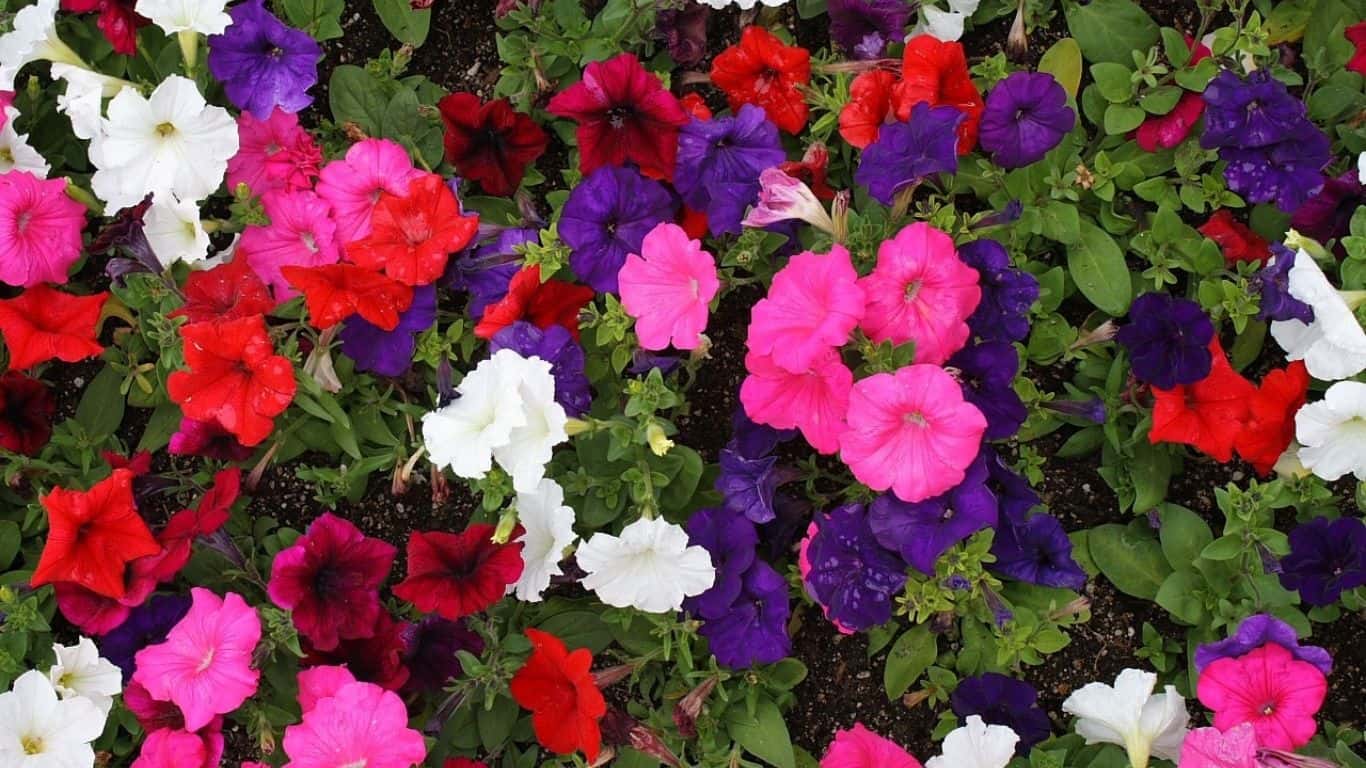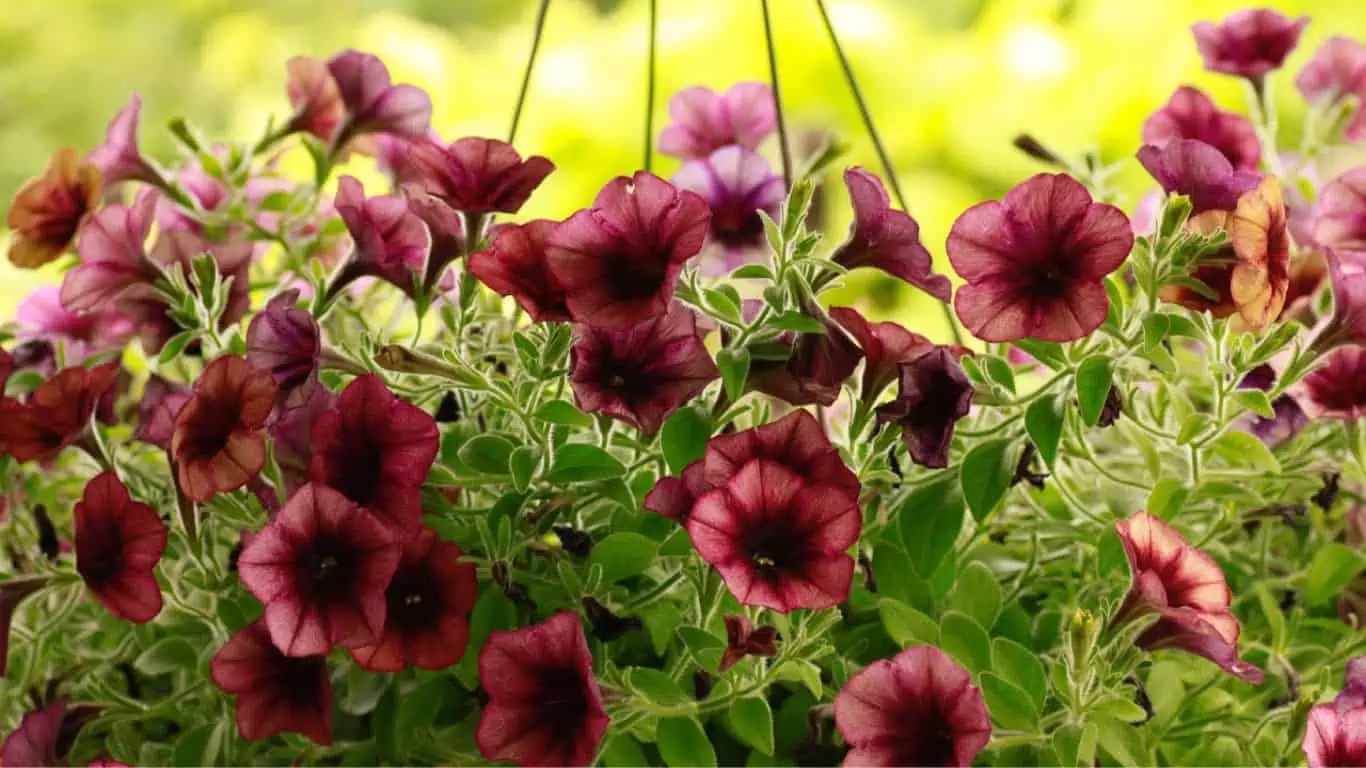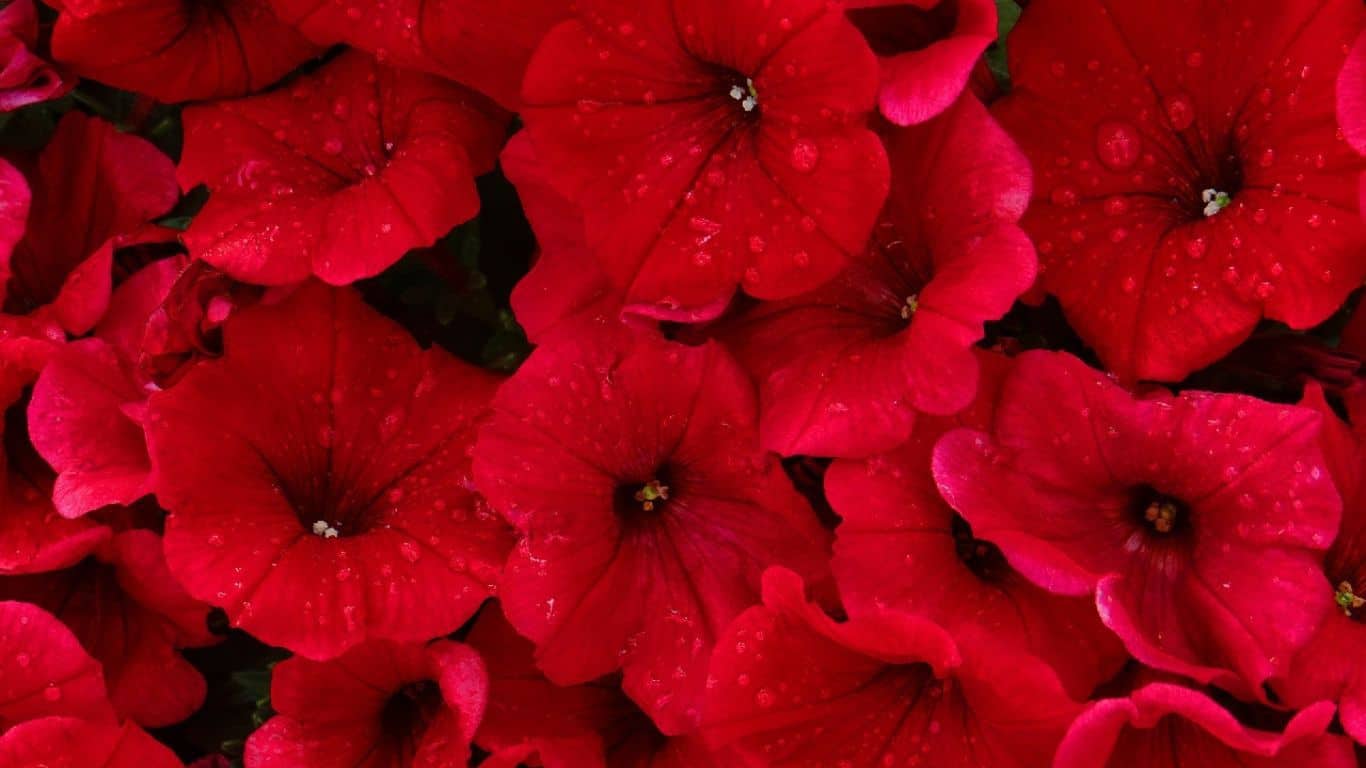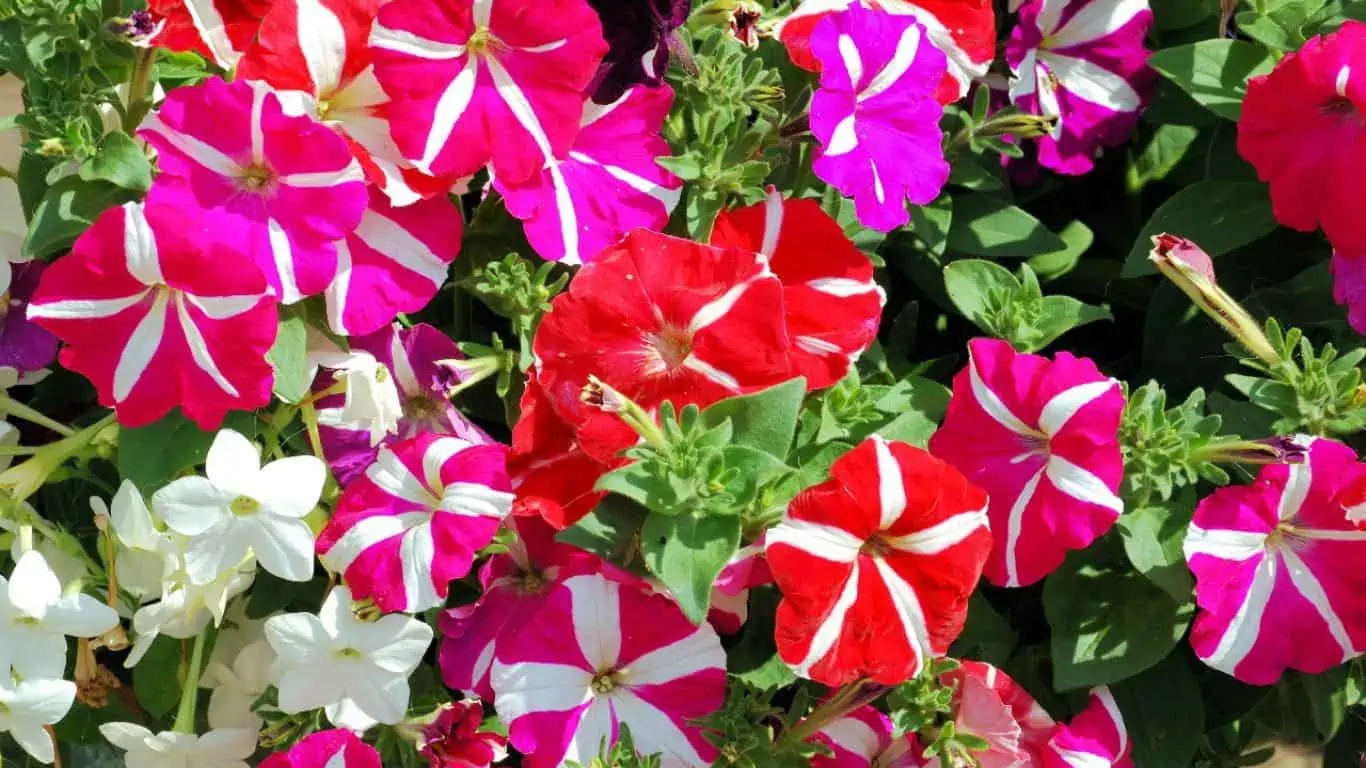Today’s topic of Discussion- How to Grow Petunia Plants? In our previous post, we learn about Are Petunias Perennial or Annual?
Petunias are beautiful flowering ornamental plants. They came in a variety of color patterns and designs. Technically these plants are perennial although they are popularly grown as Annuals. Petunias start blooming in spring and last till the first frost. Some petunia varieties have a mildly sweet fragrance that attracts bees and butterflies while others may lack it.
Petunia is one of the most popular annual flowers among home gardeners. These flowers can add a colorful contrast to the standard background of your house. The best part is you can grow them in a hanging basket and vertical gardens. In this way, you can create a natural flowering wall just with 10 or 15 petunia plants.

Also read: How to Grow Sampaguita Flowers- Jasminum Sambac
Is It Easy to Grow Petunia Plants?
Petunia plants are quite easy to grow and maintain. They can easily propagate through seeds and can grow in a variety of soil types. That’s why maintenance of petunias is not very difficult. Once the plant establishes in its environment, it will bloom without much care.
The only concern with petunia gardening is the seed germination rate and the timing for overall growth. It may take 5 or more weeks for petunia seeds to germinate as a seedling. Therefore I always recommend buying mature seedlings from the nursery, especially for home gardeners. Seed germination is not ideal if you need only a couple of petunias for your garden.
Most petunia varieties are fairly drought resistant. They don’t require frequent watering. This will save a lot of time for other garden jobs. Still, it is better to keep the soil moist and never let it dry completely.
Excessive use of fertilizers is also not necessary for petunias. Although it is better if you keep the plants well fed with liquid fertilizers. All-purpose fertilizer with compost is good for improving the quality of petunia flowers.
Altogether petunia plants are pretty easy to grow especially if you know their basic needs.
Petunia Plant Basic Info
- Family/ Genus: Petunia spp
- Common name: Petunia
- Hardiness Zone: They can grow in USDA hardiness zone 5 through 10. Different varieties are compatible in different hardiness zones.
- Origin: Original petunia varieties are native to South America. Although most modern varieties have a number of parent inheritances hence no definite origin is defined. They are grown worldwide as seasonal flowering plants.
- Plant Type: Small flowering herbs with soft delicate stem structure.
- Plant Size: Differs from 6 inches to 30 inches with varieties.
- Flower: Small 2-5 inches in diameter. They came in all colors in rainbow spectrum even in black color. Petunia with stripes and variegated color patterns are also available.
- Seasonality: Petunias blooms from Spring till late summer. In warmer regions, we can also grow then early in the fall.
- Soil Requirement: They can grow in all soil types. The soil should be soft, moist, and well-drained. A little concentration of organic matter will help better plant growth.
- Sunlight: Petunias can grow well in part shade. Although they prefer full direct sunlight for more than 6 hours every day. You should use the green net in summer to adjust to the rising temperature.
- Water: Only moderate watering is required for petunia plants.
- Uses: Petunia is an ornamental flowering plant.
When To start Petunias?
Petunia Plants need Warm Winter and Cool Summer days. Therefore if you live in frost-free zones like 10 or 11, then Start petunias in the fall. The plants will mature in winter and continue blooming till early summer. Usually, the summer season is too hot in frost-free regions. the petunia plants may not survive such high temperatures.
In colder regions, you should start petunias indoors at least 10 weeks before the last frost. This time will relate around min December. The seedling will mature to transplant by the last first date. Once the risk of frost is over move the petunia seedlings outside. These plants will keep blooming from spring through fall. They will last till the first frost during the late fall season.
Technically you should grow petunia plants when the temperature stays in the optimum range of 18-25 degrees celsius or 60-70 Fahrenheit.
Check out: Grow Crops for The Local Market in your Garden
How to Prepare Soil For Petunia Plants?
Petunia plants can grow in a variety of soil types. They don’t require very healthy or nutritious soil. These plants can grow well in soft well-drained soil even in poor sandy soil. Although for best bloom you should prepare soil mix cautiously.
It is better to use soft well-drained soil with an abundance of organic matter for petunias. Compost is a good option to increase nutrient and moisture retention in the soil mix. Any balance commercial soil mix is fine to grow petunias.
I prefer custom-made soil mix for petunias. My soil mix works for containers, hanging baskets as well as garden beds. I am using it for more than 7 years and it simply works.
It contains 30% garden soil, 20% sand, 30% compost, 10% Mustard cake powder, 5% Cocopeat or perlite and 5% NPK 18:18:18. Sometimes I also add Neem cake powder and contact fungicide in the soil to prevent fungus infestation. At last, you can add 1 spoon full of superphosphate to each Petunia plant after plantation.
This soil mix does not require further use of fertilizer at least for 75 days. Although you may apply liquid fertilizers to the petunias in proper dilution during the watering cycle.
Sunlight and Water Management for Petunias
Petunias can grow well in full sun. They prefer 6 to 8 hours of direct sunlight. You can allow full daylight in colder regions. Whereas partial shade is also good for petunias during the peak summer season.
Petunias prefer moderate temperature. The temperature should remain balanced with 18-25 degrees celsius or 60-70 degrees Fahrenheit. Therefore you should adjust the sunlight to maintain ambient temperature for the plants.
Water on the other hand is essential for hydration. The petunias prefer moderate watering just to keep the roots hydrated. They are fairly drought tolerant. Although never let the soil dry out completely. It can cause shunt growth as well as drooping of buds and flowers.
Water once or twice every week during cool weather and adjust watering with increasing temperature.
Different Types of petunia
There are mainly 4 different types of Petunias. They are characterized according to their bloom size and plant growth.
- Grandiflora (Large flower). This is the largest flower in the category. Grandiflora petunias are comfortable in warmer regions.
- Multiflora (More flower). These petunias are smaller than Grandiflora. Their small size is compensated with more blooms. Multiflora petunia is ideal for cooler regions.
- Milliflora (More Small flower). This is probably the smallest member of the petunia family. These small petunia plants bear even smaller blooms. They are best for small containers and shallow flower beds.
- Spreading Type petunias are best for ground cover. They can spread to larger spaces creating a beautiful cover full of fragrant blooms. Wave petunia is a popular spreading type of petunia.
These categories have several other subcategories. They came in a variety of colors, patterns, shapes, sizes, and designs. You can find petunia in rep, pink, blue, back, purple, or any desired color. They came in almost every color of the rainbow spectrum. How to grow Bloodroot Flowers: Sanguinaria canadensis
How to Choose Petunia Variety for Your Garden?
You should choose petunias according to the available space and growing conditions. Some varieties such as multiflora, Milliflora, and Grandiflora petunias are good for both containers as well as open garden spaces.
On the other hand, Spreading type petunias like wave petunia is best for garden cover. They can grow in containers although they bloom best in wide spreads.
petunia varieties also differ in their compatibility with temperature. Some are good for cooler regions while others may bloom well in warm zones.
If you want something simple then traditional petunia varieties are best for all types of soil and growing conditions. Hybrids are good with better bloom and adaptability with small container spaces.
Apart from the plant requirements, there are some criteria that solely depend on the gardeners. These criteria include the preference of color and patterns.
Overall you may choose your favorite color petunias and make sure they are compatible with local garden conditions.
How To Grow Petunia plants in Garden?
- You can start by purchasing a Petunia seedling from a local garden store or with petunia seeds. Keep in mind seeds will take an extra month to germinate.
- If you are planning for seed germination then start 8-10 weeks before the last frost. Seeds are cheaper than seedlings as you can grow a ton of seedlings from a packet of petunia seeds.
- Germinate the petunia seed in a moist soil mix. Use soil with equal parts of compost and sand to germinate petunias.
- Care for the petunia seedlings until they are 2-3 inches in height with 4-6 main leaves.
- Separate each seedling into an individual small 4 inches container. Let them adjust for 15 days and then transplant them outdoor after the risk of frost is over.
- Prepare garden bed with compost for new petunia seedlings. You should add a 2-4 inch layer of compost on the flower beds.
- Make a hole of the size of the root ball at a 6-8 inch distance. Grandiflora and multiflora petunias will grow well at this separation. Although you should plant spreading petunias at a minimum distance of 2 feet or 24 inches apart. They will sprawl and cover the available space so don’t overcrowd them.
- Properly place each seedling in their respective places and cover the holes with soil miz.
- Water the plants properly and make the soil damp for the first time. Water sparingly forms the next spell and keeps the soil moist through the plant life. Avoid overwatering to prevent root rot.
- Don’t forget to install stakes or support sticks for the growing petunias. This is essential to keep the plant healthy and full of blooms.
Grow Petunias In Containers

- Start with a healthy petunia seedling. You can buy them from any local garden store or from online. Make sure the seedlings are disease and pests-free before plantation.
- Use a shallow 8-10 inch wide and 6-inch deep container or any hanging basket for petunia plants. Choose petunias varieties that are comfortable with containers otherwise you may face problems in the maintenance. Multiflora and Milliflora petunias are best for container and hanging baskets.
- Fill the container with light healthy commercial soil mix or prepare one as discussed earlier.
- Make sure there are proper drainage holes in the container otherwise the plant may die due to root rot.
- Plant one 1 seedling in each container irrespective of their size. Place them properly in the center and fill their roots with the same soil mix.
- Water the plant abundantly for the first time and wait for it to drip out from the bottom hole. Reduce watering from the next spell and follow a deep watering schedule instead of shallow watering, especially for container plants.
- Take care of these plats and feed them regularly with liquid fertilizer and mustard cake brew once in 20 days. The use of all-purpose fertilizers once every moth is also helpful for faster better plant growth in petunias.
Basic Plant Care for Petunias
- Remove debris, weeds, and grass from the garden beds before planting petunias. Other plants may compete for nutrients and moisture which is not good for petunias.
- maintain proper space between each petunia plant. Grow only 1 petunia plant in containers irrespective of the container size. Keep 8-10 inch space between Grandiflora varieties and 6-8 inch space between Multiflora petunias. Milliflora petunia should be spaced at 4-6 inch distances. If you are planning for Spreading type petunias then keep them at least 2 to 4 feet away in garden beds.
- Pinching is not necessary for petunias although a light pinch in the early days can make it bushier. Never pinch or prune mature petunias, especially during flowering season else they may stop blooming.
- Deadheading is also not necessary but occasional cleanup can keep these plants healthy.
- Never water the petunias from the top. Water on the foliage can cause frequent fungal and pests problems. Pour water carefully near the root ball keeping the foliage safe.
- Allow full sunlight for best blooming in petunias. Sunlight will also help in controlling pests and fungal diseases.
- Scheduled spraying of Neem oil, soap water is helpful in the treat meant of common garden pests. Only spray in the morning which will allow the water to dry before night.
- Staking and stick support is good for petunias. These delicate soft stem plants bloom better when kept uptight with the help of stake. you can use a thin stick to create a fence or support around these plants. Tie the stem to the support and keep them up.
- There is no need to uproot the petunias at the end of the flowering season. In some places, they may survive to next season. Even if they die their fallen seeds will grow as a new seedlings.


